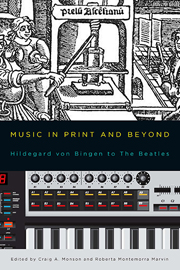Book contents
- Frontmatter
- Dedication
- Contents
- Acknowledgments
- Introduction
- 1 Robert Granjon and Music during the Golden Age of Typography
- 2 Publishing Music Theory in Early Cinquecento Venice and Bologna: Friends and Foes
- 3 Preaching to the Choir: Arts of Persuasion in the Converts of Italy
- 4 Music Distribution in London during Handel's Lifetime: Manuscript Copies versus Prints
- 5 Beethoven's Miniatures
- 6 “The Beautiful and the Ugly”: Travel Literature, Racial Theory, and a Schumann Song
- 7 Verdi's “Music of the Future”
- 8 The Suspended Voice of Amália Rodrigues
- 9 More than Mostly Mozart: Teddy Wilson's “China Boy”
- 10 Wanted Dead and Alive: Historical Performance Practice and Electro-Acoustic Music from IRCAM to Abbey Road
- 11 Lowinsky's Secrets
- 12 The Unknown Hildegard: Editing, Performance, and Reception (An Ordo Virtutum in Five Acts)
- List of Contributors
- Index
1 - Robert Granjon and Music during the Golden Age of Typography
Published online by Cambridge University Press: 05 March 2014
- Frontmatter
- Dedication
- Contents
- Acknowledgments
- Introduction
- 1 Robert Granjon and Music during the Golden Age of Typography
- 2 Publishing Music Theory in Early Cinquecento Venice and Bologna: Friends and Foes
- 3 Preaching to the Choir: Arts of Persuasion in the Converts of Italy
- 4 Music Distribution in London during Handel's Lifetime: Manuscript Copies versus Prints
- 5 Beethoven's Miniatures
- 6 “The Beautiful and the Ugly”: Travel Literature, Racial Theory, and a Schumann Song
- 7 Verdi's “Music of the Future”
- 8 The Suspended Voice of Amália Rodrigues
- 9 More than Mostly Mozart: Teddy Wilson's “China Boy”
- 10 Wanted Dead and Alive: Historical Performance Practice and Electro-Acoustic Music from IRCAM to Abbey Road
- 11 Lowinsky's Secrets
- 12 The Unknown Hildegard: Editing, Performance, and Reception (An Ordo Virtutum in Five Acts)
- List of Contributors
- Index
Summary
When compared to the broader history of printing, the history of music printing—late-blooming and faced with unique challenges—is strikingly disjunct, particularly in its early stages. The first books of polyphonic music issued from the presses of Ottaviano Petrucci almost fifty years after Gutenberg printed his forty-two-line Bible in 1455. If we take speed and the use of move-able type as indicators of the so-called Gutenberg Revolution, then music printing lagged even further behind: Petrucci relied on a double- and even triple-impression method that required running each sheet through the press at least twice, once for the metal staff lines and a second time for a forme set with metal type for letters and notes and woodblocks for large initial letters. The first examples of single-impression music printing from moveable type did not appear until around 1528; whether the first was from the presses of John Rastell in London or from Pierre Attaingnant in Paris is not known, but either way, the date was a full seventy years after Gutenberg. In fact, Petrucci's main competitor in the first decades of the sixteenth century, Andrea Antico, avoided music type entirely and printed from woodcuts, which only shows how resistant polyphony was to the technological formulas that accelerated the production of alphabetic texts.
- Type
- Chapter
- Information
- Music in Print and BeyondHildegard von Bingen to The Beatles, pp. 11 - 35Publisher: Boydell & BrewerPrint publication year: 2013

